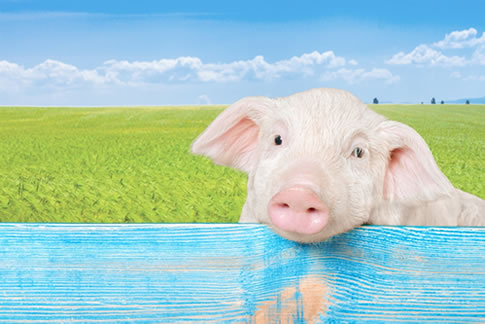Did you know that pigs are considered on the same intellectual level as chimpanzees and can often outsmart dogs? Or that pigs are actually very clean animals? Read on to learn more about these intelligent, playful, compassionate and affectionate animals.
Origin
Pigs are native to Europe, Asia and Africa. People introduced Asian pigs to Europe during the 18th and early 19th centuries. The pig’s ancestor is the wild boar. Humans introduced these animals into Australia, North and South America, and many islands either by accident (e.g., a domestic pig escapee gone wild), or as a wild boar (usually for hunting purposes). Humans domesticated pigs between 5,000 to 7,000 thousand years ago — and Hernando de Soto and other Spanish explorers first brought them to North America from Europe.
Natural Needs, Tendencies and Preferences
Wild pigs can live just about anywhere there’s available drinking water for them (because adult pigs can consume between three and five gallons of water a day). They live in small matriarchal groups often comprised of two to six sows (mother pigs) and their piglets, which can then form larger networks with other extended family members congregating in larger herds.
Wild pigs are omnivores and can consume a wide range of food but are fairly picky and prefer a variety of options. When not confined, they forage in the wild for grasses, roots, fruits, mushrooms, leaves and flowers. They will also occasionally dine on snakes, frogs, rodents, insects, and worms (but this only comprises about 4% of their diet). Because of these foraging abilities, along with an excellent sense of smell, people use some pigs in Europe to locate truffles (a type of gourmet mushroom). When left alone in a natural setting, they will spend 75% of their day engaged in rooting and foraging for up to six to eight hours.
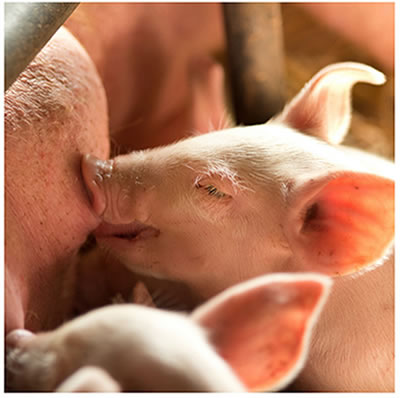 Piglets and Sows
Piglets and Sows
Baby pigs in the wild remain with their mother for two weeks, at which time they will join the rest of the herd. Pigs are excellent mothers and form a close bond to their piglets. Baby pigs are gradually weaned from their mother’s milk over approximately 12 to 17 weeks. Under normal circumstances, a sow produces one litter of piglets per year.
Wild boars can live anywhere from 11 to 25 years (where farmers who raise pigs for meat usually slaughter them at about six months).
Pigs will wallow in mud in order to keep cool, as they do not possess sweat glands. They will also use the mud to prevent sunburn and to ward off flies. In order to stay cool during warmer months, they will save a lot of their activity for nighttime.
Intelligence and Personality Traits
Pigs are curious, clean (contrary to popular belief and the dirty pig rumors), compassionate, ingenious, and social. They love to cuddle close to one another, display affection, and rub noses when greeting other pigs. Pigs are very vocal and every sound they make is used to communicate something different — emotional states, warnings, intentions and other messages to other pigs. They are highly sensitive and emotional, can suffer from depression, and every pig has its own distinct personality traits. Pigs dream and see in color, and they enjoy music.
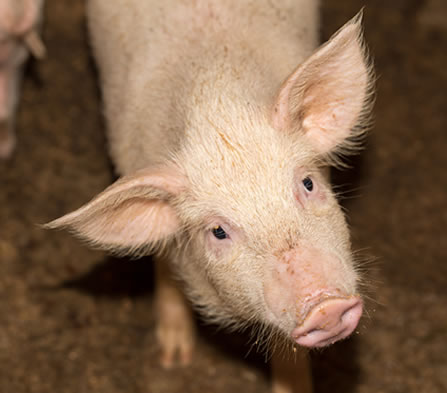 Pigs are intelligent and can be trained to perform numerous tasks and tricks — making the dwarf breeds a popular house pet. They can often outsmart dogs and are on about the same intellectual level as chimpanzees; they also share a number of cognitive capacities with elephants, dolphins and humans and are placed as the fourth most intelligent creature on earth. Pigs have excellent long-term memories, are able to figure out mazes and other object location tests, love to play, exhibit empathy, form close family bonds, can learn from one another, can comprehend symbolic language, are able to learn complex combinations of symbols for actions and objects, and have a great sense of direction. They can easily learn to operate switches and levers to obtain water and food, or to adjust ambient temperatures.
Pigs are intelligent and can be trained to perform numerous tasks and tricks — making the dwarf breeds a popular house pet. They can often outsmart dogs and are on about the same intellectual level as chimpanzees; they also share a number of cognitive capacities with elephants, dolphins and humans and are placed as the fourth most intelligent creature on earth. Pigs have excellent long-term memories, are able to figure out mazes and other object location tests, love to play, exhibit empathy, form close family bonds, can learn from one another, can comprehend symbolic language, are able to learn complex combinations of symbols for actions and objects, and have a great sense of direction. They can easily learn to operate switches and levers to obtain water and food, or to adjust ambient temperatures.
What’s Changed — A Pig’s Life Today
Traditionally, dairy farmers raised pigs on farms and allowed them to consume the milk and whey left over from the production of butter and cheese.
Domesticated pigs are called swine, and people raise them commercially for meat and for leather, and use their hair for brushes.
Approximately 100 million pigs are raised and slaughtered in the U.S. every year.
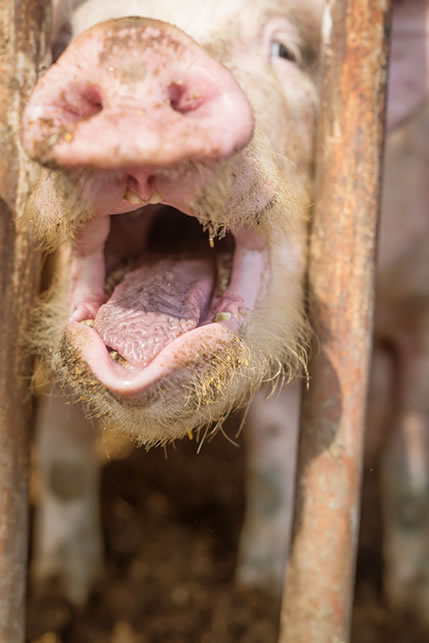 Breeding Sows
Breeding Sows
Farmers treat modern breeding sows like piglet making machines. Living a continuous cycle of impregnation and birth, the sows each have more than 20 piglets per year. After impregnating them at just seven months of age, producers confine the sows in small pens or metal gestation crates. These crates are only two feet wide. This barely allows the sow enough room to even stand or lie down; they cannot turn around or walk. Due to their circumstances, the sound of the sows banging their heads out of frustration on the bars is constant.
The gestation crate is where the sow lives on concrete flooring while she is pregnant. At the end of their 4 month pregnancy, farmers transfer the sows to farrowing crates to give birth. The sows barely have room to stand up and lie down, and many suffer from sores on their shoulders. Producers deny them straw bedding and force the sows to stand and lie on hard floors with their manure located directly below them. When asked about this, a pork industry representative wrote, “…straw is very expensive. There certainly would not be a supply of straw in the country to supply all the farrowing pens in the U.S.”
Producers move sows back and forth between the gestation crate and the farrowing crate for four to five years until their birth rate goes down, and then slaughter the sows.
Piglets
At 2 to 3 weeks of age (vs. 13 to 17 weeks in nature), producers take away the frightened piglets from their mothers for fattening. Approximately 15% of the piglets are dead by that time due to poor treatment. Producers also crowd the surviving piglets into pens with metal bars and concrete floors. As babies, farmers subject them to painful mutilations without anesthesia or pain relievers. Producers cut off the piglets’ tails and the tips their teeth (all without anesthesia) to minimize tail biting. Never mind that this is a behavior that only occurs when these highly intelligent animals are kept in factory farm environments. Farmers also take out notches of the piglets’ ears for identification — again without using any painkillers.
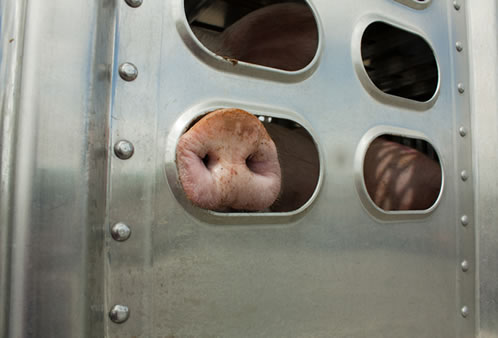
Cause and Effect
One 200 lb. pig (market weight) produces 13 pounds of manure every day. Hogs produce three times more excrement than humans. So for one factory farm with an average of 500,000 pigs, this equates to 26 million tons of manure in one year. This waste destroys rivers, kills millions of fish, pollutes the air and the land. Just ask anyone who lives near a pork factory farm and they’ll tell you all about it. Manure pits or “lagoons” also emit hundreds of toxic gases and millions of bacteria into the atmosphere.
 And it’s no big surprise to anyone that pork is an unhealthy food choice. One ounce of bacon contains 30 mg of cholesterol and about 4 grams of saturated fat; almost 70% of bacon’s calories come from fat. Consequently, eating foods where over 50% of calories are from fat puts you at risk for obesity and other diseases.
And it’s no big surprise to anyone that pork is an unhealthy food choice. One ounce of bacon contains 30 mg of cholesterol and about 4 grams of saturated fat; almost 70% of bacon’s calories come from fat. Consequently, eating foods where over 50% of calories are from fat puts you at risk for obesity and other diseases.
What Happens Next
In conclusion, Mother earth cannot continue to sustain the large-scale pig production operations and the high volume of manure, water and air pollution produced.
And the human body cannot continue to tolerate the consumption of a product that is unhealthy for it and does not meet its nutritional needs or enable it to ward off diseases.
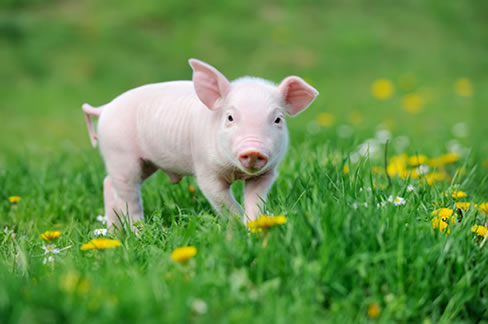 Hopefully, as more and more people connect the dots and choose plant-based foods, the planet — and the pigs and human inhabitants — will all breathe easier.
Hopefully, as more and more people connect the dots and choose plant-based foods, the planet — and the pigs and human inhabitants — will all breathe easier.
More About Pigs
History of the pig: https://livestockconservancy.org/index.php/heritage/internal/historypigs
Pig intelligence: http://www.seeker.com/iq-tests-suggest-pigs-are-smart-as-dogs-chimps-1769934406.html
Article about a large pork producer: http://www.rollingstone.com/culture/news/boss-hog-the-dark-side-of-americas-top-pork-producer-20061214
Gory Details / Other Articles (including the Slaughterhouse)
http://www.peta.org/issues/animals-used-for-food/animals-used-food-factsheets/pigs-intelligent-animals-suffering-factory-farms-slaughterhouses/
http://www.farmsanctuary.org/learn/factory-farming/pigs-used-for-pork/
Sources for this Article
Pork Production on Factory Farms, Farm Sanctuary
Pig; http://en.wikipedia.org
Origin of the Domestic Pig: Independent Domestication and Subsequent Introgression; http://www.genetics.org
History of Wild Pigs: Population introduction, Distribution, and Spread; http://wildpiginfo.misstate.edu
Sentience in Farm Animals: Pigs; http://www.think-differently-about-sheep.com
More About Pigs; http://www.humanesociety.org
IQ Tests Suggest Pigs Are as Smart as Dogs, Chimps; http://news.discovery.com

